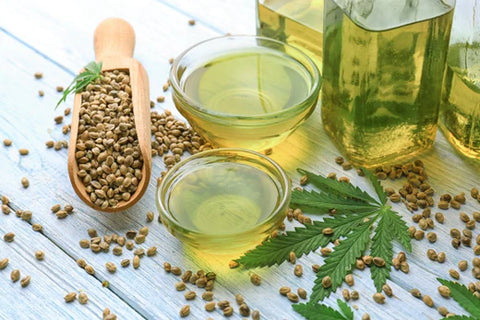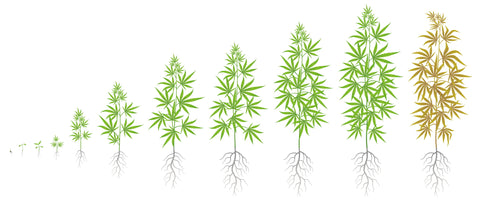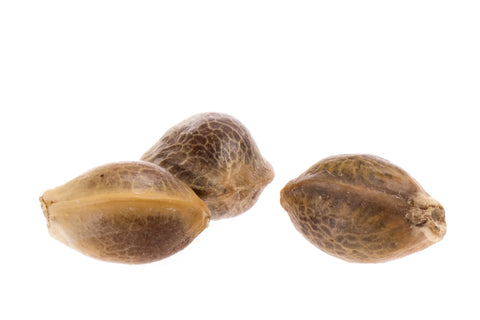Hemp Seed Oil vs. CBD Oil: Differences, Benefits, and Common Traps
Introduction
As you step into a health food store, you might notice an array of hemp products. This guide helps clarify the differences between hemp seed oil and CBD oil, ensuring you can make informed choices.

What is CBD Oil and How Is It Created from the Hemp Plant?
CBD and Cannabinoid Formation
CBD oil is derived from the aerial parts of the hemp plant, primarily the flowers, leaves, and stalks. The cannabinoid creation process begins with the hemp seed, leading to the formation of CBG, THC, and CBD. CBD is known for its health benefits, which include pain relief, anxiety reduction, and anti-inflammatory properties.
CBD, short for cannabidiol, is one of the many cannabinoids found in the cannabis plant. It interacts with the endocannabinoid system (ECS) in the body, helping to regulate various physiological processes such as mood, pain perception, and immune response. Unlike THC, CBD does not produce a psychoactive effect, making it a popular choice for those seeking the therapeutic benefits of cannabis without the high.

What is Hemp Seed Oil and How Is It Derived?
Extraction and Uses
Hemp seed oil is produced by cold-pressing hemp seeds. It is dark to clear light green in color, with a nutty flavor. Rich in essential fatty acids like omega-3 and omega-6, hemp seed oil is used in cooking, skincare products, and even industrial applications like lubricants and biodiesel. It is also highly nutritious, containing proteins, vitamins, and minerals.
Nutritional Benefits of Hemp Seed Oil
Rich in Essential Nutrients
Hemp seed oil contains over 30% fat, including linoleic acid (omega-6) and alpha-linolenic acid (omega-3). It is a great source of high-quality protein, vitamin E, and minerals such as phosphorus, potassium, sodium, magnesium, sulfur, calcium, iron, and zinc. Its well-balanced fatty acid profile can nourish the skin and relieve dryness and itchiness.
Hemp seed oil's nutritional profile makes it a valuable addition to a healthy diet. It can be used in salad dressings, smoothies, and as a finishing oil for cooked dishes. Additionally, its moisturizing properties make it a popular ingredient in natural skincare products, helping to hydrate and protect the skin.

How to Distinguish Between Hemp Seed Oil and CBD Oil
Labeling and Marketing Traps
Some companies may create confusing labels to make consumers believe they are buying CBD oil when, in fact, the product contains hemp seed oil. CBD oil should be clearly marked and may be labeled as "CBD isolate," "full-spectrum hemp oil," or "CBD-rich full-spectrum hemp oil." Hemp seed oil, often marketed for its nutritional benefits, should indicate the presence of essential fatty acids in its ingredients.
Avoiding Misleading Labels
Identifying Genuine CBD Products
To ensure you are purchasing genuine CBD oil, check for specific mentions of cannabinoids like CBD, CBG, and CBN on the label. Reputable manufacturers will provide details on the cannabinoid content and extraction process. Be cautious of vague labels and verify the product through third-party lab testing results.
When shopping for CBD oil, look for products that specify the amount of CBD per serving and confirm that the oil has been tested by an independent lab. These lab reports, often referred to as certificates of analysis (COAs), should be readily available on the company's website or upon request.
The Entourage Effect
Synergy Among Cannabinoids
The combined effect of various cannabinoids, terpenes, and flavonoids in full and broad spectrum CBD products enhances their therapeutic benefits, a phenomenon known as the "entourage effect." This synergy maximizes the potential health benefits of the cannabis plant.
Differences in Uses
Hemp Seed Oil Applications
Hemp seed oil is used in a variety of applications, including cooking, skincare, and industrial products. Its rich nutrient profile makes it a versatile ingredient in many health and wellness products.
Hemp seed oil is also used in dietary supplements, as it provides essential fatty acids that the body cannot produce on its own. These fatty acids are vital for maintaining healthy cell membranes and supporting cardiovascular health.
CBD Oil Applications
CBD oil is primarily used for its medicinal properties. It's available in various forms, including tinctures, capsules, edibles, and topicals. CBD oil is commonly used to manage symptoms of anxiety, chronic pain, and sleep disorders.
FAQs
Can hemp seed oil and CBD oil be used interchangeably?
No, hemp seed oil and CBD oil are distinct products with different uses and benefits.
Is CBD legal?
Yes, CBD is legal in the U.S. if it contains less than 0.3% THC, though state regulations can vary.
How does CBD work in the body?
CBD interacts with the endocannabinoid system, modulating CB1 and CB2 receptors to help regulate physiological processes.
What are the benefits of CBD?
CBD offers anti-inflammatory, analgesic, and anxiolytic benefits.
Can hemp seed oil benefit my health?
Yes, hemp seed oil is a nutritious supplement rich in essential fatty acids, supporting heart and skin health.
Is there THC in hemp seed oil?
No, hemp seed oil is extracted from hemp seeds and contains no THC.Conclusion
Understanding the differences between hemp seed oil and CBD oil is crucial for choosing the right product for your needs. While both offer unique benefits, they serve different purposes. Stay informed and make educated decisions to enhance your health and wellness.

Hi Dear,
I hope this message finds you well!
How can you improve your website’s search engine ranking, drive organic traffic, and enhance your online visibility?
I specialize in providing high-quality guest post backlinks on authoritative websites across various niches.
Here’s how I can help you:
✅ Relevant and Niche-Specific Backlinks
Backlinks tailored to your industry for maximum impact.
✅ High Authority Domains
Backlinks from websites with strong domain authority to boost your credibility.
✅ Customized Solutions
Tailored strategies to meet your specific goals and objectives.Whether you’re looking to rank for competitive keywords,
build a strong online presence, or outshine your competitors, I’m here to assist you every step of the way.
Would you like to explore this opportunity further? Let me know your requirements, and I’ll provide a personalized plan for your business.
Looking forward to collaborating with you!
Thanks